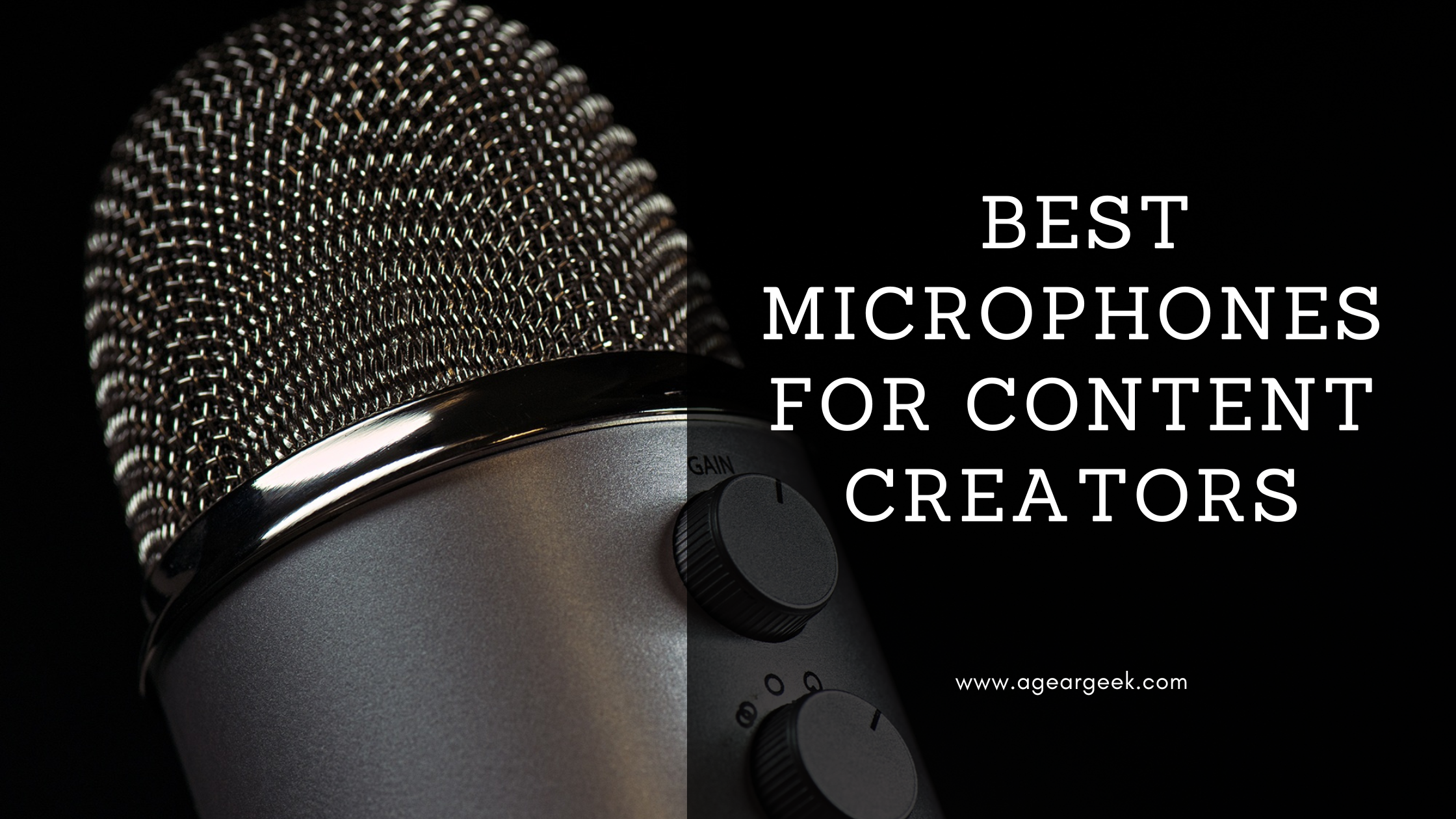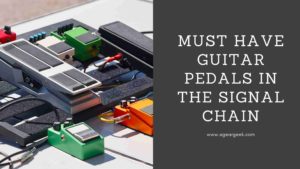If you’re looking for the best microphones for content creators, there are a lot of options out there. There’s no one-size-fits-all solution when it comes to choosing a microphone that will work best for your needs. But this list should help point you in the right direction!
Disclosure: We’re an affiliate. We hope you love the products we recommend! This post contains affiliate links. If you use these links to buy the products, we may earn a commission from the qualified sales. These are at no additional cost to you. Thank you if you use our links, we really appreciate it!
Shure SM7B
Specifications
Type: Dynamic Microphone
Polar Pattern: Cardioid
Frequency Response: 20Hz to 20kHz
Connectivity: XLR
Pros
Excellent Sound Quality
Great Built
Integrated and detachable Pop Filter
Frequency Adjusting Switches
Great background noise rejection
Cons
Gain hungry, a preamp may be required
No products found.
The Shure SM7B is a dream microphone for all content creators and it shines because of its precision and reliability. No doubt it is one of the best microphones for content creators. With a nice scoop of the low-mids and mild shaping on the high end, SM7B can potentially cover the whole audible spectrum from 20 Hz up to 20,000 Hz. Thus, SM7B is in reality an all-around option for most musical and vocal sources. It can endure a maximum sound pressure level of a scorching 180 dB.
The Shure SM7B’s two EQ settings, enable further modification of the sound, making it one of the greatest voice microphones. Both the low-cut and mid-boost switches can remove rumbling and boominess from more resonant vocal sources. The low-cut control generates a roll-off starting at 400 Hz, and the mid-boost button offers a lifted response from 900 Hz to 11,000 Hz. With these shaping choices, you can experiment with various sources with greater freedom.
Another essential component of the consistency and adaptability of the Shure SM7B is its two different types of sturdy integrated windscreens. Their thick foam prevents plosives and other air bursts from entering the capsule, which would otherwise destroy a decent vocal recording (or podcast discussion, etc.). They are also detachable, which is an excellent option when recording instruments like the guitar and drums because it allows for a direct connection between the source and the capsule without worrying about air.
It’s a fantastic piece of equipment to talk to and be heard.
Electrovoice RE20
Specifications
Type: Dynamic Microphone
Polar Pattern: Cardioid
Frequency Response: 45Hz to 18kHz
Connectivity: XLR
Pros
The classic sound of FM Radio Voice
Variable -D for minimal proximity effect
Large-diaphragm dynamic element
True cardioid with no coloration at 180 degrees off axis
Cons
A pretty hefty microphone
Slightly on the pricier side.
No products found.
The Electro-Voice RE-20 might be thought of as the broadcasting industry’s heavy weaponry. The sound tone can be characterized as neutral, deep, rich, and smooth. It is heavier and bulkier than the alternatives and has a great sweet spot. An iconic microphone and definitely deserves a place as one of the best microphones for content creators!
Because of the sound quality, RE20 has become the industry standard. It generates a steady, high-quality output. Most importantly, it guarantees the greatest background noise rejection that no condenser mic, regardless of the price range, can provide. You don’t want to accidentally record any room or street noise in a live recording because there is no way to remove it, and this is especially true for home studio setups used by most content creators.
Electro-Voice RE-20’s variable-D response ensures a consistent sound no matter how far away you are from the microphone and it is its greatest asset. It has a huge sweet spot with barely perceptible proximity changes. The RE-20’s drawbacks are its heft and its moderately high price.
Shure MV7
Specifications
Type: Dynamic Microphone
Polar Pattern: Unidirectional
Frequency Response: 20 Hz to 20kHz
Connectivity: XLR & USB
Pros
- Excellent Sound Clarity
- Flexible – able to either USB or XLR connectivity
- Touch-sensitive switch on the microphone to adjust levels and gain
Cons
Does not come with a mount
No products found.
For podcasters who demand broadcast-quality audio from their microphone, the Shure MV7 is an excellent option. The microphone has a frequency range of 20Hz to 20kHz and records at 48kHz/24-bit sample rates which are industry-standard. It does the job really well as being a dynamic microphone by rejecting unwanted background noise and is a perfect choice for content creators working from home studios. The MV7 does a fantastic job of minimizing reflected noises, such as those produced by a computer or air conditioner hum.
Having the options of both USB and XLR, it offers a much more flexible choice to the content creators. Unlike only XLR connectivity, you do not need an audio interface to use it. Irrespective of it being used via an audio interface or via USB, it sounds equally great.
The integrated touch-panel interface on the Shure MV7 lets you change a variety of settings. The control strip on the microphone panel is touch sensitive. You can Mute, and adjust the levels of headphones, or the gain of the microphone. The MV7 is a brilliant option for vocal work in any setting. Being a dynamic microphone, it can make your creative space sound a lot better.
Rode Podmic
Specifications
Type: Dynamic Microphone
Polar Pattern: Cardioid
Frequency Response: 20 Hz to 20kHz
Connectivity: XLR
Pros
Good Sound Clarity
Durable – built like a tank.
Internal pop filter, shock mount, and integrated swing mount
Great entry price point
Cons
No built-in audio filters
No products found.
Rode with their Podmic has made an impact in the dynamic microphone users’ space. With its attractive price range and with the brand name of Rode, it is massively adopted by many content creators.
First, when you get the Podmic, you feel the weight of the equipment. It is heavy and is built like a tank. Unlike the MV7, the Rode Podmic does not have any integrated software and could be connected via XLR only. So you would require an audio interface to get this working. This mic can be a great choice for any Podcaster, voice-over artist, or any content creator.
The Rode PodMic is a clear suggestion for the money, regardless of whether your goal is to become a professional content creator. You simply don’t find premium brand mics with these capabilities that are so well-built and get a terrific sound without spending a fortune.
Blue Yeti X
Specifications
- Type: Condenser Microphone
- Polar Pattern: Cardioid, Figure-8, Omnidirectional
- Frequency Response: 20 Hz to 20kHz
- Connectivity: USB
Pros
Versatile recording modes
Great audio quality
Premium build
Cons
Big & Bulky
No products found.
The Blue Yeti X is a fantastic purchase for anyone seeking high-end audio quality without having to deal with mixing decks. The Yeti X can record audio at up to 48kHz/24-bit and has a frequency range of 20Hz to 20kHz. It also has internal damping to minimize plosives. Since the Yeti X lacks a pop filter, some users might still decide to use one, which is never a bad idea. However, the Yeti X’s grille and interior foam combination operate wonderfully on their own.
Being a condenser microphone, it is way more sensitive than the Dynamic Broadcast mics discussed above. When using the Yeti X, you need to be careful otherwise it has the potential to pick up unnecessary background sounds, which can blemish a good live recording.
Whatever is said, the Yeti X is a fantastic choice of microphone for any content creator. The simplicity of use and the quality of sound make it a preferred choice for many. Albeit a bit pricey, you have to consider that you do not have to invest in additional equipment like an audio interface or preamp.
Which one do we recommend?
All the ones listed above are truly exceptional microphones for content creators. But if we have to choose two out of these, then those would be Shure SM7B and Electrovoice RE20. Both of these are iconic microphones and are considered the best in their categories. None other comes even close. These are pure gold standards.
No products found.
Conclusion
Hope this article gives you a decent understanding of some of the most commonly used microphones by content creators. Some of the ones listed in this article are not only the best but are iconic. The RE20 and SM7B fall in that category while MV7 and Podmic are new kids in the block making huge waves. The Yeti X is a kind of its own with brilliant sound characteristics. Apart from microphones for content creators, you may also want to check out these articles on home studio, headphones, and studio monitors which may also help you in your content-creating journey.
Last update on 2024-05-03 / Affiliate links / Images from Amazon Product Advertising API





